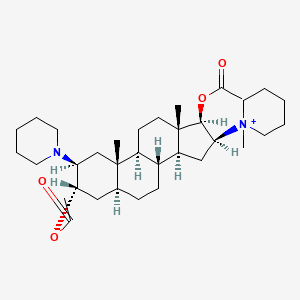Attribution Statement: LactMed is a registered trademark of the U.S. Department of Health and Human Services.
NCBI Bookshelf. A service of the National Library of Medicine, National Institutes of Health.
Drugs and Lactation Database (LactMed®) [Internet]. Bethesda (MD): National Institute of Child Health and Human Development; 2006-.
CASRN: 86029-43-8

Drug Levels and Effects
Summary of Use during Lactation
No information is available on the use of vecuronium during breastfeeding Because it is short acting, highly polar and poorly absorbed orally, it is not likely to reach the breastmilk in high concentration or to reach the bloodstream of the infant.[1,2] When a combination of anesthetic agents is used for a procedure, follow the recommendations for the most problematic medication used during the procedure. General anesthesia for cesarean section using vecuronium as a component may delay the onset of lactation.
Drug Levels
Maternal Levels. Relevant published information was not found as of the revision date.
Infant Levels. Relevant published information was not found as of the revision date.
Effects in Breastfed Infants
Relevant published information was not found as of the revision date.
Effects on Lactation and Breastmilk
A randomized study compared the effects of cesarean section using general anesthesia, spinal anesthesia, or epidural anesthesia, to normal vaginal delivery on serum prolactin and oxytocin as well as time to initiation of lactation. General anesthesia was performed using propofol 2 mg/kg and rocuronium 0.6 mg/kg for induction, followed by sevoflurane and rocuronium 0.15 mg/kg as needed. After delivery, patients in all groups received an infusion of oxytocin 30 international units in 1 L of saline, and 0.2 mg of methylergonovine if they were not hypertensive. Fentanyl 1 to 1.5 mcg/kg was administered after delivery to the general anesthesia group. Patients in the general anesthesia group (n = 21) had higher post-procedure prolactin levels and a longer mean time to lactation initiation (25 hours) than in the other groups (10.8 to 11.8 hours). Postpartum oxytocin levels in the nonmedicated vaginal delivery group were higher than in the general and spinal anesthesia groups.[3]
References
- 1.
- Spigset O. Anaesthetic agents and excretion in breast milk. Acta Anaesthesiol Scand. 1994;38:94–103. [PubMed: 8171959]
- 2.
- Dalal PG, Bosak J, Berlin C. Safety of the breast-feeding infant after maternal anesthesia. Paediatr Anaesth. 2014;24:359–71. [PubMed: 24372776]
- 3.
- Kutlucan L, Seker IS, Demiraran Y, et al. Effects of different anesthesia protocols on lactation in the postpartum period. J Turk Ger Gynecol Assoc. 2014;15:233–8. [PMC free article: PMC4285212] [PubMed: 25584032]
Substance Identification
Substance Name
Vecuronium
CAS Registry Number
86029-43-8
Disclaimer: Information presented in this database is not meant as a substitute for professional judgment. You should consult your healthcare provider for breastfeeding advice related to your particular situation. The U.S. government does not warrant or assume any liability or responsibility for the accuracy or completeness of the information on this Site.
- User and Medical Advice Disclaimer
- Drugs and Lactation Database (LactMed) - Record Format
- LactMed - Database Creation and Peer Review Process
- Fact Sheet. Drugs and Lactation Database (LactMed)
- Drugs and Lactation Database (LactMed) - Glossary
- LactMed Selected References
- Drugs and Lactation Database (LactMed) - About Dietary Supplements
- Breastfeeding Links
- PMCPubMed Central citations
- PubChem SubstanceRelated PubChem Substances
- PubMedLinks to PubMed
- Review Pancuronium.[Drugs and Lactation Database (...]Review Pancuronium.. Drugs and Lactation Database (LactMed®). 2006
- Review Rocuronium.[Drugs and Lactation Database (...]Review Rocuronium.. Drugs and Lactation Database (LactMed®). 2006
- Vecuronium bromide and its advanced intermediates: A crystallographic and spectroscopic study.[Steroids. 2021]Vecuronium bromide and its advanced intermediates: A crystallographic and spectroscopic study.Ciceri S, Colombo D, Ferraboschi P, Grisenti P, Iannone M, Mori M, Meneghetti F. Steroids. 2021 Dec; 176:108928. Epub 2021 Oct 13.
- Review Cisatracurium.[Drugs and Lactation Database (...]Review Cisatracurium.. Drugs and Lactation Database (LactMed®). 2006
- Review Atracurium.[Drugs and Lactation Database (...]Review Atracurium.. Drugs and Lactation Database (LactMed®). 2006
- Vecuronium - Drugs and Lactation Database (LactMed®)Vecuronium - Drugs and Lactation Database (LactMed®)
Your browsing activity is empty.
Activity recording is turned off.
See more...
